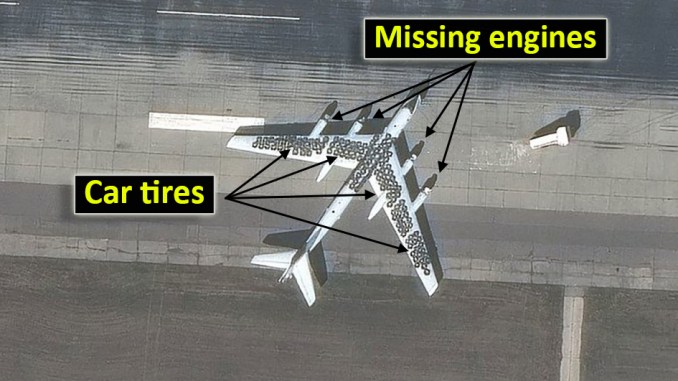
The new satellite photos of some Tu-95s covered with car tires and missing their engines have prompted new theories.
Few days ago, satellite imagery of Engels-2 airbase, located in Saratov Oblast, some 400 km southeast of Moscow and roughly 700 km from the border with Ukraine, emerged online showing Tu-95 Bear strategic bombers with wings and a small section of the upper fuselage covered with car tires. The reason for that was not completely clear.
According to the Ukrainian sources, the the car tires were used as a sort of makeshift protection from attacks carried out with kamikaze drones a theory that we have already analysed here.
New hi-rez MAXAR satellite imagery published by CNN, provides a closer look at the tire-laden Tu-95 and Tu-160 bombers, highlighting some interesting details. Upon close inspection, it appears, in fact, that one Bear bomber is missing its left-hand inner engine, while another one doesn’t have propellers installed on its engines. This obviously sparked new theories.
In fact… now that I look at the other one, it doesn’t have any blades on any of the engines. pic.twitter.com/nyObvlfLcN
— Evergreen Intel (@vcdgf555) September 6, 2023
With the anti-drone makeshift protection theory still standing, an immediate new theory would be the tires being used as counterweight to compensate for the missing engine and propellers. Considering that there are about 50 tires on the Tu-95 and the bomber’s Kuznetsov NK-12 engine weight being about 3,000 kg, the theory could be valid or not, depending if those are really car tires or aircraft tires and their weight.
Someone suggested the car tires were used as part of a makeshift protection from attacks carried out with kamikaze drones.
The War Zone speculated it could be a way to deceive the radar guidance of the Ukrainian Neptune missiles and other long-range missiles that use image matching for targeting, by breaking up the infrared signature of the targeted bombers, a technique also frequently referred to as DSMAC (Digital Scene Matching Area Correlator) or ATR (Automated Target Recognition) when used in cruise missiles.
Interestingly, it looks like the presence of the tires has altered the SAR (Synthetic Aperture Radar) signatures of the bombers.
@SatimMonitoring has detected unusual changes in the TU-95 and TU-160 bomber’s SAR signatures using @umbraspace SAR imagery of the Engels-2 military base (#Russia). Characteristics of the captured signal reflections don’t match the aircraft’s known geometry & material composition pic.twitter.com/3q3beYZ0wQ
— SATIM Inc. (@SatimMonitoring) September 5, 2023
However, Engels-2 base, is at least 600 km (372 miles) from the nearest Ukrainian territory, a distance that is well beyond the range of the Neptune, believed to be 400 km (250 miles).
Whatever, Russia has already shown attempts to deceive satellites and/or missiles target recognition systems with adopting “deceptive camouflage”.
***BREAKING***
New technology sees through #Russian attempt to hide ships from #Ukraine using ‘deceptive camouflage’
Very interesting for anyone doing #OSINT, impressive ship detection / identification algorithms from @SatimMonitoring https://t.co/OJwzEuK9jD
— H I Sutton (@CovertShores) July 12, 2023
The last theory, this one supported also by the missing parts, sees these as decommissioned drones being used as decoys in case of kamikaze drones’ attacks.
- SEO Powered Content & PR Distribution. Get Amplified Today.
- PlatoData.Network Vertical Generative Ai. Empower Yourself. Access Here.
- PlatoAiStream. Web3 Intelligence. Knowledge Amplified. Access Here.
- PlatoESG. Automotive / EVs, Carbon, CleanTech, Energy, Environment, Solar, Waste Management. Access Here.
- PlatoHealth. Biotech and Clinical Trials Intelligence. Access Here.
- ChartPrime. Elevate your Trading Game with ChartPrime. Access Here.
- BlockOffsets. Modernizing Environmental Offset Ownership. Access Here.
- Source: https://theaviationist.com/2023/09/06/mystery-deepens-over-tu-95-tires/?utm_source=rss&utm_medium=rss&utm_campaign=mystery-deepens-over-tu-95-tires





